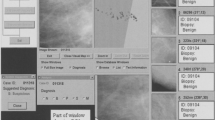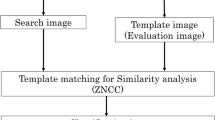Abstract
The purpose of this study was to investigate four objective similarity measures as an image retrieval tool for selecting lesions similar to unknown lesions on mammograms. Measures A and B were based on the Euclidean distance in feature space and the psychophysical similarity measure, respectively. Measure C was the sequential combination of B and A, whereas measure D was the sequential combination of A and B. In this study, we selected 100 lesions each for masses and clustered microcalcifications randomly from our database, and we selected five pairs of lesions from 4,950 pairs based on all combinations of the 100 lesions by use of each measure. In two observer studies for 20 mass pairs and 20 calcification pairs, six radiologists compared all combinations of 20 pairs by using a two-alternative forced-choice method to determine the subjective similarity ranking score which was obtained from the frequency with which a pair was considered as more similar than the other 19 pairs. In both mass and calcification pairs, pairs selected by use of measure D had the highest mean value of the average subjective similarity ranking scores. The difference between measures D and A (P = 0.008 and 0.024), as well as that between measures D and B (P = 0.018 and 0.028) were statistically significant for masses and microcalcifications, respectively. The sequential combination of the objective similarity measure based on the Euclidean distance and the psychophysical similarity measure would be useful in the selection of images similar to those of unknown lesions.








Similar content being viewed by others
References
Doi K: Current status and future potential of computer-aided diagnosis in medical imaging. Br J Radiol 78:s3–s19, 2005
Doi K: Computer-aided diagnosis in medical imaging: historical review, current status and future potential. Comput Med Imaging Graph 31:198–211, 2007
Doi K: Computer-aided diagnosis moves from breast to other systems. Diagn Imag 29:37–40, 2007
Kumazawa S, Muramatsu C, Li Q, et al: An investigation of radiologists’ perception of lesion similarity: observations with paired breast masses on mammograms and paired lung nodules on CT images. Acad Radiol 15:887–894, 2008
Bucci G, Cagnoni S, De Dominicis R: Integrating content-based retrieval in a medical image reference database. Comput Med Imaging Graph 20:231–241, 1996
Wong ST, Huang HK: Design methods and architectural issues of integrated medical image data base systems. Comput Med Imaging Graph 20:285–299, 1996
Swett HA, Fisher PR, Cohn AI, et al: Expert system controlled image display. Radiology 172:487–493, 1989
Swett HA, Mutalik PG, Neklesa VP, et al: Voice-activated retrieval of mammography reference images. J Digit Imaging 11:65–73, 1998
Qi H, Snyder WE: Content-based image retrieval in picture archiving and communications systems. J Digit Imaging 12(2 Suppl 1):81–83, 1999
Sklansky J, Tao EY, Bazargan M, et al: Computer-aided, case-based diagnosis of mammographic regions of interest containing microcalcifications. Acad Radiol 7:395–405, 2000
Giger ML, Huo Z, Vyborny CJ, et al: Intelligent CAD workstation for breast imaging using similarity to known lesions and multiple visual prompt aids. Proc SPIE 4684:768–773, 2002
Sinha U, Kangarloo H: Principal component analysis for content-based image retrieval. Radiographics 22:1271–1289, 2002
Aisen AM, Broderick LS, Winer-Muram H, et al: Automated storage and retrieval of thin-section CT images to assist diagnosis: system description and preliminary assessment. Radiology 228:265–270, 2003
Kawata Y, Niki N, Ohmatsu H, et al: Example-based assisting approach for pulmonary nodule classification in three-dimensional thoracic computed tomography images. Acad Radiol 10:1402–1415, 2003
El-Naqa I, Yang Y, Galatsanos NP, et al: A similarity learning approach to content-based image retrieval: application to digital mammography. IEEE Trans Med Imaging 23:1233–1244, 2004
Zheng B, Lu A, Hardesty LA, et al: A method to improve visual similarity of breast masses for an interactive computer-aided diagnosis environment. Med Phys 33:111–117, 2006
Nakayama R, Watanabe R, Namba K, et al: An improved computer-aided diagnosis scheme using the nearest neighbor criterion for determining histological classification of clustered microcalcifications. Methods Inf Med 46:716–722, 2007
Li Q, Li F, Shiraishi J, et al: Investigation of new psychophysical measures for evaluation of similar images on thoracic computed tomography for distinction between benign and malignant nodules. Med Phys 30:2584–2593, 2003
Muramatsu C, Li Q, Suzuki K, et al: Investigation of psychophysical measure for evaluation of similar images for mammographic masses: preliminary results. Med Phys 32:2295–2304, 2005
Muramatsu C, Li Q, Schmidt RA, et al: Experimental determination of subjective similarity for pairs of clustered microcalcifications on mammograms: observer study results. Med Phys 33:3460–3468, 2006
Muramatsu C, Li Q, Schmidt RA, et al: Determination of subjective similarity for pairs of masses and pairs of clustered microcalcifications on mammograms: comparison of similarity ranking scores and absolute similarity ratings. Med Phys 34:2890–2895, 2007
Muramatsu C, Li Q, Schmidt RA, et al: Investigation of psychophysical similarity measures for selection of similar images in the diagnosis of clustered microcalcifications on mammograms. Med Phys 35:5695–5702, 2008
Muramatsu C: Investigation of similarity measures for selection of similar images in computer-aided diagnosis of breast lesions on mammograms. Ph.D. dissertation, The University of Chicago, Chicago, IL (ProQuest/UMI, Ann Arbor, MI, 2008)
Kendall M, Gibbons JD: Rank correlation methods, 5th edition. Oxford University Press, New York, 1990
Heath M, Bowyer K, Kopans D, et al: Current status of the digital database for screening mammography. In: Digital mammography. Dordrecht: Kluwer Academic, 1998
Acknowledgments
We are grateful to Kirti Kulkarni, MD, Charlene Sennett, MD, Rajshri Shah, MD, Steven G. Thiel, MD, and Akiko Shimauchi, MD, for participating in the observer study; to Chisako Muramatsu, PhD, for her useful suggestions; and to Elisabeth Lanzl for improving the manuscript. K. Doi is a shareholder in Hologic/R2 Technology, Inc., Los Altos, CA, USA. CAD technologies developed in the Kurt Rossmann Laboratories have been licensed to R2 Technology, Deus Technologies, Riverain Medical Group, Mitsubishi Space Software Co., Median Technologies, General Electric Corporation, and Toshiba Corporation. It is the policy of The University of Chicago that investigators disclose publicly actual or potential significant financial interests that may appear to affect research activities or that may benefit from research activities.
Author information
Authors and Affiliations
Corresponding author
Rights and permissions
About this article
Cite this article
Nakayama, R., Abe, H., Shiraishi, J. et al. Evaluation of Objective Similarity Measures for Selecting Similar Images of Mammographic Lesions. J Digit Imaging 24, 75–85 (2011). https://doi.org/10.1007/s10278-010-9288-3
Published:
Issue Date:
DOI: https://doi.org/10.1007/s10278-010-9288-3




